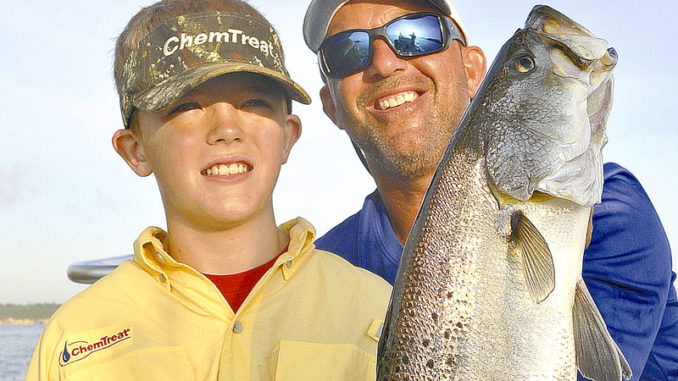
Ten reef sections are already attracting specks
A new, positive fishing factor emerged for New River anglers pursuing specks in the past couple of years.
“Ten oyster-highway reef sections are in place and already attracting fish,” said guide Ricky Kellum of Jacksonville, N.C. “I’ve already caught fish at them, and they should be good for topwater bites throughout July.”
Spotted seatrout will hold in the usual places in the river, plus the man-made oyster reefs, part of an “oyster-highway” project supported by a number of conservation organizations. When the reefs are all in line, the oyster highway will be 38 miles long. Oyster rocks and young oysters have been placed intermittently along the route. Specks and other gamefish are attracted to oyster reefs.
“Right now, each of the 10 places are about the size of a basketball court and marked,” Kellum said. “But you need to fish topwater lures or popping corks to keep them above the oysters in wire cages or you’ll hang lures that run too deep.”
Walk the dog
His favorite July topwater lure for specks is a pink Skitter Walk.
“Zara Spook Jrs. also will catch specks, but a Spook scatters fish when you throw on top of them,” he said. “The lightweight Skitter Walk doesn’t make as much of a splash. If (it’s) calm, and the water is slick, I’ll throw the Skitter Walk. If the water’s rough, I’ll throw the (Spook) because fish can see and hear it better.
“You need to sit out at least 20 feet from the oyster reefs. You can throw lures or popping-cork rigs over them, then work across them. Red drum love live shrimp, too.”
The New River’s shoals and points also will be gathering places for trout because shrimp start showing up in good numbers.
Kellum’s artificial-lures tackle includes a 7-foot, Star Plasma II medium-light rod and a Stradic 2500 spinning reel spooled with 10-pound braid and 2 feet of 25-pound mono leader.
Slip-cork rigs also work well
When summer is in full bloom and the guide takes less-experienced anglers, he’ll switch to a tried-and-true live bait: shrimp. And he may try spots with normal bottoms, not oyster reefs, that have produced big specks in the past.
“The best outfit for people who don’t cast lures well or haven’t learned yet to work them is float-fishing with a slip-cork rig,” he said. “That carries me through the summer with family charters.”
He likes to find relatively deep, 8 to 10 feet, channels with moving current, particularly during falling tides.
“Trout hang out near the bottom of channels and wait for shrimp to come by,” Kellum said. “I fish places where I know the depth, so I set the bobber-stopper to put the shrimp 2 feet off the bottom. The shrimp might be 2 feet off the bottom of a 10-foot hole. Most of the time, trout can’t resist it.”
Using live-shrimp, Kellum’s clients regularly land citation trout and sometimes other species such as red drum, bluefish and even Spanish mackerel.



Be the first to comment